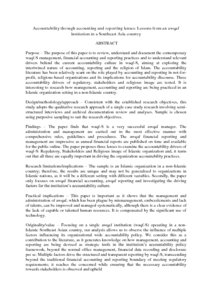Citation
Yaacob, Hisham and Petra, Saerah and Sumardi, Azimah and Nahar, Hairul Suhaimi
(2015)
Accountability through accounting and reporting lenses: lessons from an awqaf institution in a Southeast Asia country.
Humanomics, 31 (3).
pp. 299-313.
ISSN 0828-8666
Abstract
Purpose – The purpose of this paper is to review, understand and document the contemporary waqf-S management, financial accounting and reporting practices and to understand relevant drivers behind the current accountability culture in waqf-S, aiming at exploring the intertwined nature of accounting, reporting and the religion of Islam. The accountability literature has been relatively scant on the role played by accounting and reporting in not-for-profit, religious-based organizations and its implications for accountability discourse. Three accountability drivers of regulatory, stakeholders and religious image are tested. It is interesting to research how management, accounting and reporting are being practiced in an Islamic organization setting in a non-Islamic country.
Design/methodology/approach – Consistent with the established research objectives, this study adopts the qualitative research approach of a single case study research involving semi-structured interviews and archival documentation review and analyses. Sample is chosen using purposive sampling to suit the research objectives.
Findings – The paper finds that waqf-S is a very successful awqaf manager. The administration and management are carried out in the most effective manner with comprehensive rules, guidelines and procedures. The awqaf financial reporting and management are impressive as annual financial reports are published on time and available for the public online. The paper proposes three lenses to examine the accountability drivers of waqf-S: Regulatory, Stakeholders and Religious image of Islamic organization and, it turns out that all three are equally important in driving the organization accountability practices.
Research limitations/implications – The sample is an Islamic organization in a non-Islamic country; therefore, the results are unique and may not be generalised to organizations in Islamic nations, as it will be a different setting with different variables. Secondly, the paper only focuses on awqaf financial accounting, awqaf reporting and investigating the driving factors for the institution’s accountability culture.
Practical implications – This paper is important as it shows that the management and administration of awqaf, which has been plague by mismanagement, embezzlements and lack of talents, can be improved and managed systematically, although there is a clear evidence of the lack of capable or talented human resources. It is compensated by the significant use of technology.
Originality/value – Focusing on a single awqaf institution (waqf-S) operating in a non-Islamic Southeast Asian country, our analysis allows us to observe the influence of multiple factors influencing its organizational wide accountability policy. We consider this as a contribution to the literature, as it generates knowledge on how management, accounting and reporting are being devised as strategic tools in the institution’s accountability policy framework, beyond the normal office management, financial data recording and disclosure per se. Multiple factors drive the structured and transparent reporting by waqf-S, transcending beyond the traditional financial accounting and reporting boundary of meeting regulatory requirements; it reaches the concerned while ensuring that the necessary accountability towards stakeholders is observed and upheld.
Download File
![[img]](http://psasir.upm.edu.my/43637/1.hassmallThumbnailVersion/Accountability%20through%20accounting%20and%20reporting%20lenses%20Lessons%20from%20an%20awqaf%20institution%20in%20a%20Southeast%20Asia%20country.pdf)  Preview |
|
PDF (Abstract)
Accountability through accounting and reporting lenses Lessons from an awqaf institution in a Southeast Asia country.pdf
Download (104kB)
| Preview
|
|
Additional Metadata
Actions (login required)
 |
View Item |

